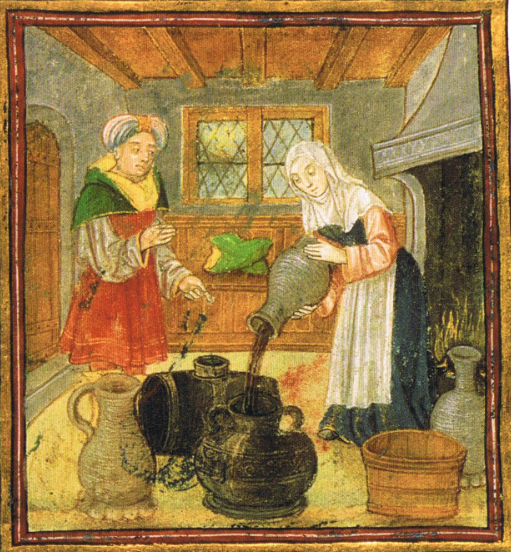
Today in the Western world, ale and beer brewing is a male-dominated industry, but this has not always been the case. In medieval English rural and urban spaces women were often brewers, either independently or with their husbands. The image to the left shows a husband and wife brewing in their home which was common in the medieval period. The tools needed to make ale were commonly found in medieval homes as it was the primary beverage. Ale and beer brewing around the 13th and 14th centuries was considered unskilled labor, making it a common field for women. Many women and families brewed for personal consumption and sold the excess leading to increased demand and space for ale, beer, and taverns. Brewing afforded women of various social standings modest independence in the form of controlling their own labor and business.
The Black Death devastated England in the mid-14th century greatly impacting labor across the country. Medieval scholars argue whether or not post-Black Death was a “Golden Age” for women since more women worked in various unskilled labor forces and dominated several industries, such as weaving and ale brewing. Even though women were prominent in these fields, it did not lead to equality or make a lasting impact on their treatment.
Relations between men and women and their behavior were heavily regulated by Church doctrine. For women, the Bible and the Church’s interpretation of the text led to widespread misogyny that infiltrated every aspect of medieval life. Women were believed to be inherently wicked and deviant, characteristics that colored everything they did and touched. For alewives and independent female brewers, this belief made work difficult. Ale and beer were drunk for sustenance and not for their alcoholic properties. Still, many believed that alewives' inventions were to deliberately intoxicate their patrons and lead them down a path of debauchery. Taverns and alehouses were also associated with deviancy and prostitution, fueling the misconceptions that alewives and their labor were prostitute adjacent.
Not only were alewives scrutinized socially, but local officials heavily regulated their labor and industry. Ale prices were based on grain prices and set by local mayors, aldermen, and sheriffs. These same figures frequently inspected ale for quality and to ensure alewives and brewsters were not cheating their customers. Alewives and brewsters already attracted suspicion as women in public spaces, and the high level of regulation compounded these attitudes. While some alewives committed unlawful acts, like Alice de Caustone of London who cheated customers with false measures of ale, these instances were not unique to women or their labor. Rumors were dangerous to alewives and brewsters and could destroy their businesses. For example, Christine Colmere of Canterbury lost her brewing business in 1413 when her neighbor accused her of having leprosy. Women brewers faced unique social and legal obstacles to their labor that they had to contend with in order to be successful. However, by the 16th century, as England’s population began to bounce back, women were slowly ousted from the brewing industry as it transformed from unskilled to skilled labor. Women’s brief control of the brewing industry adds to the complexities of the lives of medieval English women. While their labor and industry were heavily regulated by male institutions, their labor offered them a sliver of legal and economic independence.






